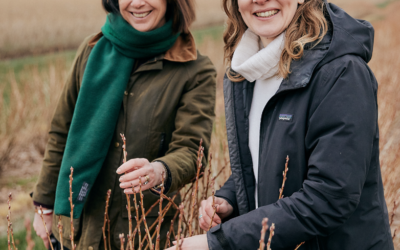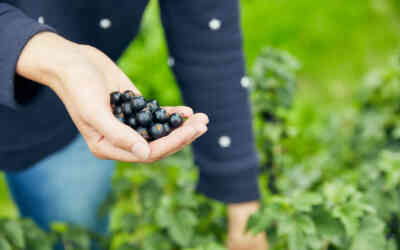A Year As A Blackcurrant Grower

Looking to grow your own blackcurrants? If so, we’ve broken your blackcurrant-growing journey down into three simple steps and shared our top tips to see you from one start of the year to another…
Planting
Blackcurrant plants are typically sold as two-year-old bushes, and the months of November, December, January, February and March are the best time to plant these in the ground; this is known as the ‘dormant’ season. It’s best to avoid planting in the middle of winter when the ground can be too wet or frozen. Blackcurrant plants prefer full sun but will cope with light shade. The plants are sensitive to frost, so avoid planting in drafty areas, as cold winds and late frosts can damage flowers and reduce the crop.
If you have space to plant several plants, we’d suggest selective varieties that produce fruit from the early to late season to ensure a fruitful harvest for most of the summer.
Our growers plant blackcurrant cuttings into the ground – but it will take three years for these to produce their first proper crop for Ribena.
Harvesting
When your blackcurrants are big, shiny, and dark purple, they’re ready to pick! Harvest your crops on a dry day, as wet blackcurrants can spoil quickly. Once picked, your blackcurrants will keep in the fridge for several days. Take a look at our recipe for some delicious fruity inspiration.
If you’re looking to freeze your blackcurrant to enjoy later in the year, we’d recommend freezing them on a baking tray so they freeze individually before adding them into a freezer bag. This makes them much easier to grab a handful rather than having to defrost all the fruit that is stuck together.
Depending on the variety, your blackcurrants will be ready for harvesting from early summer onwards. The Blackcurrant Foundation harvest starts mid-July, typically in Kent, and ends mid-August in Dundee, Scotland.
Maintenance
Once the harvest is over, your bushes will need maintenance to ensure a healthy crop next year. To encourage new stems to grow, the bushes will need pruning annually in winter. If you’ve had strong growth, we recommend pruning lightly, whereas if growth has been weak, then a hard prune is better – cut at least half the shoots back near ground level.
When spring comes back around, the great British weather can still be unpredictable. Any late frosts can be very damaging to the overall yield of the bush. Once the bush has flowered, the flowers are incredibly delicate. Frosts can cause the flowers to fall off, and one flower = one blackcurrant! On nights when frost is forecast, it’s good to be prepared and protect bushes in flower by covering them with a fleece or cloth.
We’d love to see how you get on growing your own and the delicious ways you choose to enjoy your crops once they’re ready! Follow us on Instagram, and don’t forget to tag us in your photos – @ukblackcurrants.
YOU MAY ALSO WANT TO READ
What Spring means to blackcurrants…
This month has been a busy one our blackcurrant farms! Spring brings the return of the warmer weather, and the fields of woody brown branches suddenly transform into fields of beautiful green. Spring is always a significant point in the year as life returns to the...
A list as long as ‘Blackcurrants’
We've got a list as long as 'Blackcurrants' as to why you should be adding these delicious berries to your diet. The cold weather has set in, and cold and flu season is here, so give your immune system a boost with the power of purple berries! Read on to find out...
A Year in Recipes
Hello December! As the year comes to an end, we like to reminisce by rediscovering our favourite purple berry recipes! As we slow down for the festive season, it gives us the time to try that recipe we've had our eye on or discover a new firm favourite. From crisp,...




